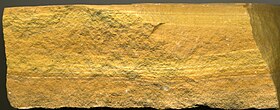Bentonite
Bentonite is a very fine-grained (colloidal) clay of the montmorillonite type that contains bases and iron. It has applications in ceramics, among other uses. The name derives from a deposit found in Fort Benton, United States.
Features
The size of the particles is less than 0.03% of the average kaolinite grain. The most normal type is calcium. Soda swells when it comes into contact with water. The iron it contains always gives it color, although there is also a white bentonite. This type will give better color on reduction than on oxidation when used on porcelain bodies. It also helps to suspend the varnish.
There are various types of bentonite that vary in plasticity and hardness. There are a few, such as fuller's earth, that lack plasticity.
It is a very sticky clay with a high degree of shrinkage (the bonds between unit layers allow a greater amount of water to enter than kaolinite) and has a tendency to fracture during firing and cooling. For this reason it is not convenient to work it alone or as the predominant material of a dough.
Applications
- In civil engineering and foundations, to sustain land, in the form of bentonite mud.
- In construction, like sealing material.
- In drilling wells to extract water, oil or natural gas, used in the preparation of drilling sludges.
- In the manufacture of lubricating fats.
- In the elaboration of aromatizers.
- In the wine industry as an inorganic clarifier.
- In the in vitro transcription from DLPs (double layer particles) of Rotavirus.
- In animal feed for the elimination of food toxins.
- In humans it is attributed detoxifying effects at the physical and non-chemical level.
- In metallurgy the sodium bentonite and the calcium as aglutinant of the quartz sand to manufacture cast moulds.
- Sands or sanitary pebbles for herring of cats (mascots).
- As an additive for tixotropic or impermeable paintings.
- In the preparation of electrodes for grounding.
- To fill up vertical geothermal catching wells due to its good heat conductivity and its homogeneous mix without bubbles, which facilitates contact with the probes.
- Like desicculating or absorbing moisture.
Contenido relacionado
Uranium
Gene
Dactyloctenium
